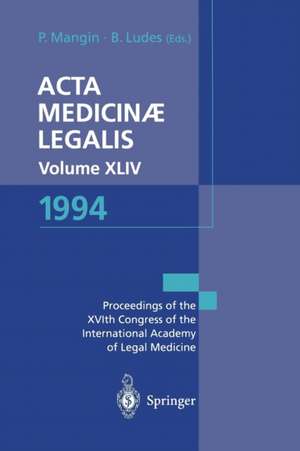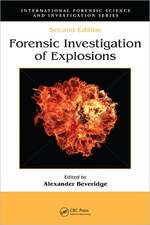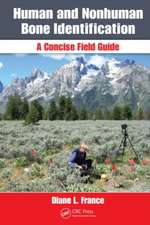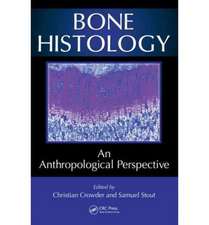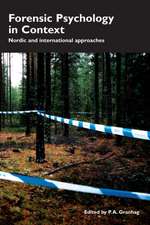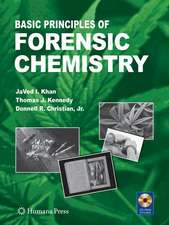Acta Medicinæ Legalis. Volume XLIV. 1994: XVIth Congress of the International Academy of Legal Medicine and Social Medicine, Strasbourg, France, 31 May – 2 June, 1994 / XVIème Congrès de l’Acadèmie Internationale de Mèdecine Lègale et de Mèdecine Sociale Strasbourg, France, 31 mai-2 juin 1994
Editat de Patrice Mangin, Bertrand Ludesen Limba Engleză Paperback – 20 apr 1995
Preț: 382.99 lei
Preț vechi: 403.15 lei
-5% Nou
Puncte Express: 574
Preț estimativ în valută:
73.29€ • 76.09$ • 61.11£
73.29€ • 76.09$ • 61.11£
Carte tipărită la comandă
Livrare economică 22 martie-05 aprilie
Preluare comenzi: 021 569.72.76
Specificații
ISBN-13: 9783540588474
ISBN-10: 3540588477
Pagini: 556
Ilustrații: XX, 533 p. 42 illus.
Dimensiuni: 155 x 235 x 29 mm
Greutate: 0.77 kg
Ediția:Softcover reprint of the original 1st ed. 1995
Editura: Springer Berlin, Heidelberg
Colecția Springer
Locul publicării:Berlin, Heidelberg, Germany
ISBN-10: 3540588477
Pagini: 556
Ilustrații: XX, 533 p. 42 illus.
Dimensiuni: 155 x 235 x 29 mm
Greutate: 0.77 kg
Ediția:Softcover reprint of the original 1st ed. 1995
Editura: Springer Berlin, Heidelberg
Colecția Springer
Locul publicării:Berlin, Heidelberg, Germany
Public țintă
ResearchDescriere
Professor Patrice MANGIN President of the XVlth Congress of the International Academy of Legal Medicine and Social Medicine The International Academy of Legal Medicine and Social Medicine was founded in 1938 in Bonn. The motive for founding the Academy was to promote associating and confronting on an international background the scientific research work produced in the various domains dealing with the Legal and Social Medicine. As first presi dent of the International Academy of Legal Medicine and Social Medicine, Professor Knud Sand from Copenhagen, assisted by colleagues of the Praesidium appointed as national representatives, succeeded in gathering together nearly the whole aca demic people involved in Legal and Social Medicine. Thus one year later, in 1939, The Academy became a worldwide institution of 450 members from thirty nations. After the war, what had been before of considerable interest for the progress of the knowledge and techniques in Legal Medicine remained again a pressing necessity leading to the second meeting of the Academy in 1947 in Brussels under the presi dency of Professor De Laet. Since then the meetings of the Academy followed one another every three years. At this point, I would like to thank all the past presidents of the Academy and in particular Professor Roche and Professor Andre for their contribution without which the Academy would not be what it is presently.
Cuprins
1. Plenary Session.- Legal Medicine in Europe.- Who is Who in Forensic Sciences — Suggestion of a Biographical Archive for Common Benefit.- 2. Advances in DNA technology.- PCR-Based Analysis from Formalin-Fixed and Paraffin-Embedded Tissues.- Past, Present and Future Trends in Forensic DNA Technologies in Europe.- Evaluation of an Automated DNA-Extractor for DNA Profiling.- Deficiency Cases in Disputed Paternity.- Application of PCR to a Forensic Casework: Identification of Burned Human Remains.- Cadaveric DNA Extraction Protocol Based on Cetyl Trimethyl Amonium Bromide (CTAB).- Polymarker and HLA DQA1 Genetic Markers in Forensic Casework.- Studies on HLA DQ Alpha Genotypes carried out from Dental Material discovered Subsequently on the Scene of the Aircrash of Flight IT 5148.- Allele Frequencies of HLA-DQA1, LDLR, GYPA, HBGG, D7S8 and GC in the Resident Population of the Basque Country.- HUMTHoi (TCii) and HUMFESFPS (FES) Alleles Distribution in a South West Swiss Population.- Genetic Typing of Biological Evidence using PCR.- Suitability of Short Tandem Repeats in Forensics: a Comparison of 7 Loci.- Detection of Sex Specific DNA Fingerprint bands in Peregrine Falcon using Non Radioactive 33.6 and 33.15 Human Probes.- Genetic Analysis of Fluorescent labeled Amplified DNA using Series of Oligonucleotide Probes Covalently Bound to Membranes.- P. C. R. Amplification of D. N. A. from Amniotic Fluid in a Paternity Study following a Rape.- P.C.R. Generated Allele Frequencies in the Spanish Population.- Positive Identification of a Couple of Flood Victims by Autopsy Data and PCR Investigation.- Amplified Fragment Length Polymorphism Analysis of the VNTR Locus D1S80 in Asturias (North-West Spain).- Frequency Database for the D2S44 Locus using Dig-Labeled YNH24 Probe in the Basque Country Population.- Investigation of D1S80 VNTR Locus in a Polish Population.- Usefulness of D1S80 System in Paternity Investigation.- Detection of a New Large Allele at the D17S5 (YNZ22) Locus.- PCR Applications of Genotyping in Borderline Casework.- Use of the Amplitype PM Coamplification System on Forensic Analysis.- French Caucasian Population Data for HUMTH01 and HUMFESFPS Short Tandem Repeat (STR) Systems.- Application of the Amplitype PM Coamplification System to Forensic Casework.- Application of DNA Polymorphisms to Postmortem Paternity Cases.- Comparison between the Consanguinity Determination by a Multi-Locus Probe and Three Single-Locus Probes.- Typing of Mucoid Cell Stains at Bite Marks on Victims of Sexual Homicide Crimes.- Forensic Application of two Short Tandem Repeat Systems: HUMTH01 and HUMvWA31.- 3. Ethics and Forensic Psychiatry.- The Ontogeny of Pathological Sexuality.- Violation of Human Rights by the Soviet Regime in Latvia. Medico-Legal Aspects.- The Consent of the Minor as Bone Marrow Donor in European Community Countries.- à l’Etude des Problèmes de l’Ethique en Psychiatrie Médico-Légale.- Causal Explanation and Understanding in Psychiatric Forensic Examination.- The Behavior Consequences in Undesirable-Child Syndrome.- Enjeux Ethiques des Législations Nouvelles de Santé Mentale.- Activity of the Medical Ethics Committee of the Marseilles University Hospital Centre.- The Hurriet Law and Bioethics Committees.- Mass Murders and Serial Killings: a Study of 43 Victims.- Social Attitudes towards the Latest Legislation on Brain Death.- Contribution au Respect des Droits de l’Homme par des Echanges entre Psychiatres Légistes Russes et Français.- Prendre en Charge les Sexopathes, en France dès 1994.- Problèmes Ethiques dans certaines Situations Limites de l’Expertise Psychiatrique.- La Convention Européenne des Droits de l’Homme et la Question des Hospitalisations sous Contrainte.- 4. Post Mortem Chemistry.- Thanatochemical Blood Changes in a few Beggars and Tramps Social Cases.- Estimation of Post-Mortem Interval based on the Changes of Phosphorylase Activity in Skeletal Muscles.- Electrical Fatalities — Serum Myoglobin Concentration as a Characteristic Marker?.- Post-Mortem Chemistry: Its Applications to Diagnosis.- 5. Toxicology.- Determination of Nicotine and Cotinine in Ancient Human Bone Samples.- Drug Abuse Substances in the Case Record (1988–1992) of the Institute of Forensic Medicine — Milan University.- Interest of Including Dextropropoxyphene Research in Systematic Toxicological Screening: Poisonings and Forensic Aspects.- Hair Extraction for Drugs of Abuse by Coca-Cola (TM): The Ultimate Method.- Fatal Chloroquine Poisoning — Clinical Course and Autopsy Findings.- Four Human Hydrogen Sulphide Inhalation Fatalities by Industrial Hazard.- Comparative Study of Biological Fluids Ethanol Concentrations.- Drug Induced and Drug Related Deaths in 1993 at the Medico-Legal Institute of Lisbon.- Development of Hepatitis B-, Hepatitis C- and HIV-Prevalence among Drug Abuse-Related Fatalities (Hamburg 1984–1993).- Influence of Antemortem Medication on the Determination of Brain Death.- Medico-Legal Evaluation of Drug Addiction. Prospective Study.- Experimental Studies on Concentration-Time Profiles of Ethanol and Acetaldehyde in Various Organs.- Post-Mortem Distribution and Histologic Study on A Fatal Case due to Accidental Ingestion of Carbon Tetrachloride.- Acute Methamidophos Poisoning.- Fatal Intoxication of Goats by Pendimethalin (Stomp) Herbicide.- 6. Jurismedicine.- On the Doctor’s Duty to Inform the Patient in Austria.- Adverse Drug Reactions and Medical Malpractice.- Transsexuality. Socio-Professional Handicap in Portugal.- Diplopie Iatrogénique: Possible Responsabilité Professionnelle.- 7. Pathology.- Experimental Studies on Postmortem Interval, using a Deep Thermometer.- Sudden Death in Pregnancy caused by Bleeding from Arteriovenous Malformation in Brain Stem.- Civilian Massacre in Uzdol, Bosnia and Herzegovina.- Medico-Legal Connexions of Ruptured Cerebral Vascular Abnormalities.- An Acid Bath Murder.- Traumatic Thrombosis of the Internal Carotid Artery: Two Cases by Different Pathogenesis.- Suicidal Firearm Wounds of the Head by a 5. 56 mm Bullet — Report of Two Cases.- Hepatic Steatosis: Effect and Cause — Forensic and Social Medicine Significations.- The Glial Cell Alteration in Some Cases of Sudden Death. An Etidpathogenical Assessment.- Neonaticide in Paris 1987–1992.- Manner of Death — Difficulties in Determination and Importance of Autopsy.- Deaths Related to Iatrogenic Complications: Five Years’ Experience among Coroner’s Autopsies in a General Hospital.- Place of the Scanning Electron Microscope in the Taxonomic Identification of Diatoms in the Diagnosis of Drowning.- Cerebral Embolism after an Abdominal Trauma. Case Report.- About Forensic Problems of Post-Mortem Examinations in Seine-Saint Denis (Paris Northeastern Suburb).- Some Medicolegal Characteristics of Homicides with Female Victims.- Personal Identification of Plicae Palatine in Evolutive Age.- A Child Abuse by Anorectal Penetration. A Case Report.- A Possible Mistake between an Entrance Hole and a Fistule Orifice.- Study of Natural Death in Rural Area of Catalonia (1980 – 1989).- Comparison of Two Extraction Methods of Diatoms Extractions from Organ Samples in the Diagnosis of Drowning.- Nail-Gun Suicide.- Death Cases due to Gas Weapons — Autopsy Findings and Experiments.- The Value of Ultrastructural Study of the Lungs in Diagnosing Asphyxiated Deaths in Mice.- Changing Profile of the Manner of Deaths in Adana.- Multiple Suicidal Gunshot Wounds.- Studies on Examples of Drowning with Fresh Water Inhalation — Cerebral Blood Flow and Blood Electrolyte Levels.- Statistical Estimation of Diagnostic Accuracy of Sudden Infant Death Syndrome (SIDS) in Japan.- Homicide in the Bathtub.- Détermination de la Distance de Tir par Analyse d’Images: Radiographie des Résidus de Tir au Calibre. 22lr.- An Autopsy Case of Traumatic Sinus Thrombosis.- Medico-Legal Study on the Skin Color of Cadavers Exposed to Exhaust Fumes.- Retrospective Post-Mortem Study of 118 Pedestrians.- Application of Rigid Endoscopes for Forensic Examination of Stab Wounds.- Positive Findings in the Heart Conduction System (HCS) in Cases of Sudden Death.- Delayed Subdural Hematoma due to Minor Head Injury.- Dynamics on Subcellular Localization of Leukotoxin (9:10-epoxy-12-octadecenoic Acid) in Lungs of Rats as revealed by Immuno-Electron Microscopy.- Sex Determination with a Discriminate Function Analysis of Deciduous Teeth Size in Plaster Models.- Identification of Calvarium Thanks to the After-Effects of a Mastoidectomy.- 8. Forensic Odonto-Anthropology.- Teeth Present, Teeth Missing and Probability: Usefulness in Comparative Identification.- Determination of the Legal Age in the Adult by Examination of the Teeth: Graphs and Pathological Variations.- Identifying a Bank Robber.- Index for Recording Tooth Abrasion Microfailures. T. A. M. Index for Determination of Puech Number.- An Attempt of Scientific Evaluation in Facial Reconstruction: Preliminary Results.- Determining the Legal Age between 12 and 14 Years Old: Contribution from Radiographic Examination of Dental Mineralization.- 9. Clinical Legal Medicine.- Clinical Legal Medicine.- Kinetic Visual Acuity and Alcohol Ingestion.- Clinical Legal Medicine.- Les Violences sur Mineurs en Seine Saint Denis.- Les Violences faites aux Femmes en Algérie: du Social au Judiciaire.- The Medico-Legal System in Turkey, Undergraduate and Postgraduate Curriculum of the Forensic Sciences.- Purse Snatching: the Aged as Triple Victims.- 10. Bodily Damage Evaluation in Europe.- Le Mandat d’Expertise pour l’Evaluation du Dommage Corporel — Projet d’un Modèle Européen Unifié.- L’Evaluation des Souffrances Endurées chez le Sujet en Etat Végétatif Persistant.- Interest of Evoked Potentials in the Medico-Legal Assessment in the Professional Hearing Loss.- Evaluation of Neuropsychological Sequelae in Electrical Injuries.- Réflexions sur l’Aggravation et l’Etat Antérieur dans la Réparation du Dommage Corporel.- Un Cas de Blessure Mortelle par Projectile de Pistolet de Scellement.- Professional Handicap in Victims of Lower Limb Traumatisms. Preliminary Study.- Handicapped People in Portugal.- La Réparation du Dommage Corporel en Europe: Tentative d’Harmonisation.- 11. Time of Death Estimation.- Computer Simulation of the Effect of Thermal Insulation on the Post Mortem Body Temperature.- High Blood Alcohol levels in Cadaverous Blood.- “Normal” Values in Vitreous Humor — Reflections and Refutations.- Vitreous Potassium Determination as an Indicator of Post-Mortem Interval.- Estimating the Post-Mortem Interval in Immersed Cadavers: the Example of an Animal Model.- 12. Interpretation of Post Mortem Toxicological Data.- Comparison between Morphine Levels in Subjects Who died of Acute Narcotism and Subjects Who died of Other Causes.- Carbon Monoxide Suicide by Car Exhaust Gas.- Toxicological Findings after Several Years of Burial.- Comparison between Morphine Levels in the Blood and in the Musculo-Skeletal System of Subjects who died of Acute Intravenous Narcotism.- Artefactual Cyanide Formation from Ranitidine (ZantacTM) in a Postmortem Gastric Content.- 13. Mass Disasters.- Radiological Investigation in a Major Disasters — The Lockerbie Panam Plane Crash.- Air-Crash Victims Identification: Scene, Autopsy Room and Laboratory Investigations in an Italian Case.- Teaching Disaster Medicine: Training in Preservation of Evidence Necessary for Identification Purposes.- Identification of the Victims of Aircraft Accident at the Ohrid Airport.- Odontological Identification of the Victims of Flight AI. IT 5148 Air Disaster. Lyon-Strasbourg 20.01.1992.- Forensic Identification of the Victims of the Airbus A320 Crash (20.1.1992).- DNA Fingerprinting for Post-Mortem Forensic Identification: Successful Application to the Identification of Aircrash Victims.- Identification of the Victims of the Air Crash of Kafoutine (Senegal) Which took place on February 9th 1992.- The Disaster Victims Identification Team of the French National Gendarmerie.- Medical Inspection after the Earthquake in Southwest of Hokkaido in Okushiri Island.- Mass Accidents on Motorways: Some Biomechanical and Medicolegal Considerations upon an Epidemiological Study.- 14. Systematic Toxicological Analysis.- Toxicological Analysis of Drugs: GC-MS Screening and Confirmation.- General Approach of Systematic Toxicological Analysis — Current Status and Future.- 15. Forensic Aspects of Drug Addiction.- The Importance of Standards and Regulations Derived from Toxicology for the Protection of Human Health and the Environment by the Public Health Authority.- Evaluation and Development of Narcotics after Analysis of Seized Samples in the North of France 1989–1993.- Quantitative Determination in a Substitution Programme with Levomethadone.- Thymus Alterations Related to Intra-Venous Drug Abuse or Early HIV Infection.- Driver Fitness of Heroin Addicts Substituted with Methadone.- The Science and Politics of Drug Testing in the USA.- 16. Entomology.- Application de l’Entomologie à la Pratique Médico-Légale: Prélèvements sur le Cadavre.- L’Expertise Entomologique Médico-Légale et ses Résultats.- Entomology Application to Time of Death Determination.
Textul de pe ultima copertă
This book contains the scientific reports of recent advances in legal medicine and directly related sciences.
Various topics are covered by leading scientists in the fields of clinical legal medicine, bodily damage evaluation, and forensic odontoanthropology, and also biological advances such as toxicology and DNA technology including polymorphic DNA systems such as VNTR, STR, and other PCR based polymorphysms. Ethical problems and forensic psychiatry and jurismedicine are also treated.
Thus, this volume offers useful data and methods that can be directly used by scientists working in the fields of forensic and legal medicine, forensic science, toxicology, population genetics, anthropology, forensic odontology, ethics, and forensic psychiatry.
Various topics are covered by leading scientists in the fields of clinical legal medicine, bodily damage evaluation, and forensic odontoanthropology, and also biological advances such as toxicology and DNA technology including polymorphic DNA systems such as VNTR, STR, and other PCR based polymorphysms. Ethical problems and forensic psychiatry and jurismedicine are also treated.
Thus, this volume offers useful data and methods that can be directly used by scientists working in the fields of forensic and legal medicine, forensic science, toxicology, population genetics, anthropology, forensic odontology, ethics, and forensic psychiatry.
